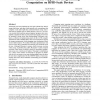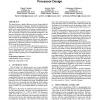139 search results - page 11 / 28 » High-level languages for small devices: a case study |
RE
2008
Springer
13 years 6 months ago
2008
Springer
This paper proposes a two-step approach to identifying ambiguities in natural language (NL) requirements specifications (RSs). In the first step, a tool would apply a set of ambig...
SBIA
2004
Springer
14 years 1 months ago
2004
Springer
This paper presents an overview of current work on the recognition of sign language and a prototype of a simple editor for a small subset of the Brazilian Sign Language, LIBRAS. Ha...
ASPLOS
2011
ACM
12 years 11 months ago
2011
ACM
Transiently powered computing devices such as RFID tags, kinetic energy harvesters, and smart cards typically rely on programs that complete a task under tight time constraints be...
IWPC
2000
IEEE
14 years 2 days ago
2000
IEEE
Call graphs are commonly used as input for automatic clustering algorithms, the goal of which is to extract the high level structure of the program under study. Determining the ca...
VLSID
2005
IEEE
14 years 8 months ago
2005
IEEE
This paper presents a highly efficient processor design methodology based on the LISA 2.0 language. Typically the architecture design phase is dominated by an iterative processor ...


